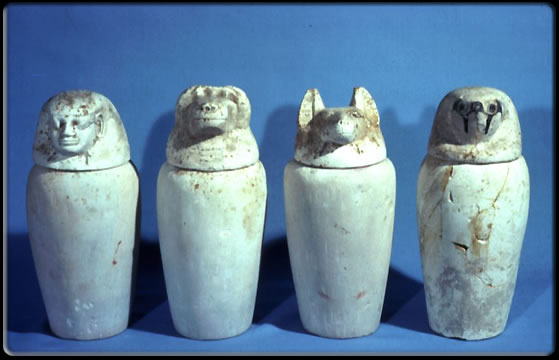
Mummification

Death Is Only The Beginning
The process of mummification took place over a 70 day period. For whatever reason, Egyptians did not have a high regard for the brain. Therefore, the embalmers, using an instrument much like a crochet hook, removed chunks of the brain through the nostrils and simply discarded it.
Using great care, the embalmers then made the smallest possible slit in the side of the abdomen to remove the lungs, liver, stomach and intestines. The heart was left in place. Each of the removed organs were placed in four separate Canopic Jars - one for each son of Horace. Canopic Jars were typically made of limestone and measured approximately 16 inches tall.
Canopic Jars
- Liver: Imseti (human)
- Lungs: Hapi (baboon)
- Stomach: Duamutefla (dog)
- Intestines: Qebehsenuef (falcon)
Natron
The next step involved using Natron, a combination of baking soda and salt, which was packed inside the abdominal cavity and approximately 250 to 300 pounds of it was used to cover the exterior of the body. Natron drew the moisture from the flesh. The body was left to cure for about 35 days.
The Rub Down
After the curing process, the embalmers removed the Natron, then they stuffed the abdominal cavity with linen or a suitable substitute. The next step was to rub the body down with various oils to make the skin pliable.
Wrapping Linens
After the rub down was complete, the wrapping of the corpse began. Layer after layer of linen, decorated with hieroglyphic prayers, was carefully wrapped around the corpse. A small amulet was placed over the heart, which was the only organ left in place. A pharaoh would typically have several amulets placed on the body.
The Tomb
As for the tomb, it would often contain items that the deceased would think necessary in the afterlife. For example, they would have food, a book, a comfortable chair, etc., to make their afterlife more comfortable.
Pharaohs would obviously have all of these necessities and more. Of course gold would be at the top of the list, but they would also have things like figurines that could be used as servants. Whenever a pharaoh needed a task to be done, he would simply summon one the figurine servants to take care of the matter.
The Benediction
Finally, when all of the preparations were completed, a benediction or prayer was offered to the deceased, and they began their journey into the afterlife.